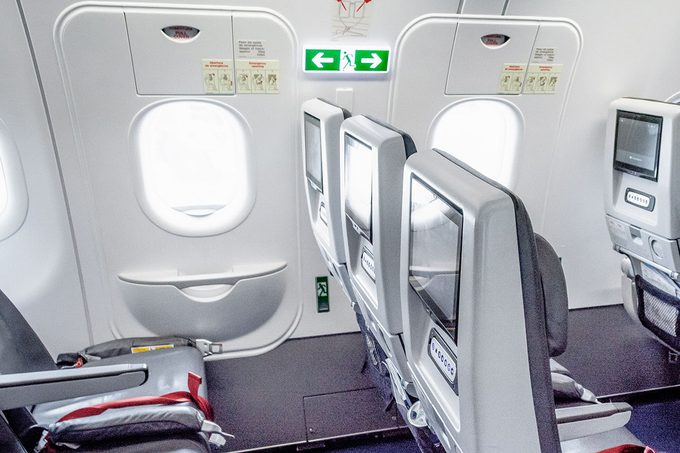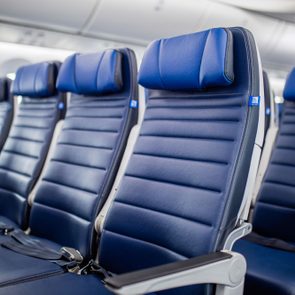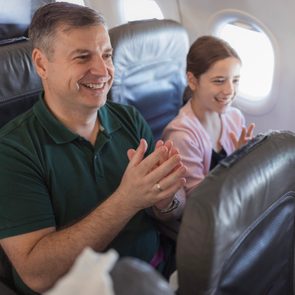Let's just say, it's not a good idea

Here’s What Would Happen If You Try Opening the Emergency Exit Door Mid-Flight

Every time you fly, you sit through the same safety demonstration, where flight attendants explain how to put an oxygen mask over your face and use your seat cushion as a flotation device. They also gesture toward the emergency exits—typically one in the front and one in the rear of the aircraft. Most of the time, there isn’t a reason to think about these emergency doors for the rest of the flight.
But perhaps you’re curious about what happens when someone opens the emergency exit door, either on the ground or mid-flight. How would it affect aircraft safety? Is it even possible to open one of these doors? While it doesn’t happen often, there are a handful of times when passengers (and in one instance, a flight attendant) took it upon themselves to open the forbidden exit door. Read on to learn more about these events, as well as the design of emergency exit doors and how planes have changed over the years.
Get Reader’s Digest’s Read Up newsletter for more travel, humor, cleaning, tech and fun facts all week long.
What is an emergency exit actually for?
The purpose of emergency exits is to be able to evacuate the plane quickly, says Dan Bubb, PhD, a former airline pilot and current aviation safety expert and professor at University of Nevada, Las Vegas. If there was an emergency and all the passengers on a plane had to exit the aircraft through fewer doors, the process would take much longer. “The emergency exit door literally could mean the difference between life and death,” Bubb says.
When it comes to emergency exits, every detail is carefully planned, from their advanced safety mechanisms that enable the doors to work under challenging conditions to their placement throughout the aircraft. Emergency exits are located throughout the cabin, so all passengers are relatively close to one. That’s why flight attendants ask the people seated in exit rows if they are willing to help people evacuate the aircraft in the event of an emergency.
What happens if you try to open the emergency exit on an airplane on the ground?

If you open an emergency exit door while the plane is on the ground and unpressurized, it will open and the inflatable slide will deploy, Bubb says. There are multiple examples of people opening the emergency door while the plane was still on the ground, including the 2010 incident when JetBlue flight attendant Steven Slater announced he was quitting his job, grabbed two beers from the drinks cart, opened the door, activated the slide and fled.
Many emergency exits are plug-type doors, which “fit snugly into the door frame, creating a seal that is reinforced by the pressure differential between the inside and outside the aircraft,” according to Aviation Services. The doors come equipped with hardware—including vertical rod and rim exit devices—that maintain the seal. Or, as TikToker and YouTuber Pilot PascalKlr puts it: “We pressurize our aircraft to a lower altitude so that you guys can breathe. The inside pressure pushes the door in its frame.” However, when the aircraft is on the ground, the pressure equalizes and the door can be opened by disengaging the locking mechanism.
What about when the plane is on the ground but moving? According to American Airlines First Officer Steve Scheibner, who goes by Captain Steeeve on TikTok, once the aircraft accelerates up to a speed of 80 knots (roughly 92 miles per hour), a mechanism on the doors locks, meaning they cannot be opened.
Why can’t you open the emergency exit mid-flight?
It is virtually impossible to open the emergency door mid-flight because of pressurization between the cabin and outside air, Budd says. “The air pressure inside of the plane is much greater than the pressure outside of the plane,” he explains. “This makes it exceedingly difficult to open the door. Also, there are door locks to add an additional level of safety.”
To be able to open an emergency door of an aircraft mid-flight, you’d need to be able to lift 25,000 pounds, Scheibner says. “Once this door gets pressurized in flight, it’s nine pounds per square inch,” he says in a video from November.
If you tried to open the door while the plane is pressurized and somehow was successful, “it would create a decompression situation where the oxygen masks would fall from the ceiling, and the pilot would have to put the plane in a dive to an altitude of 14,000 feet within four minutes,” Bubb explains. However, this is physically impossible, he notes.
One notable exception to this is the man who, in 2023, opened the emergency door of an Asiana Airlines plane roughly three minutes before landing because he said he felt suffocated and wanted to get off the plane immediately. At that point, the aircraft was only about 700 feet off the ground, meaning that there was less of a pressure differential between the outside and inside of the plane, and the emergency exit wasn’t as hard to open. Fortunately, there were only 12 people with minor injuries out of the 200 people onboard.
But this isn’t likely to become common practice. In fact, Ryan Irwin, a pilot with more than 10 years of experience flying Boeing 787 and 737 commercial jets, told Afar that the incident was “one of the first of its kind.”
Have you ever been able to open emergency exits on airplanes mid-flight?
According to Bubb, while he was going through pilot training, the only time he was able to open the emergency exit door was when the plane was parked on the ground. But there are two examples of people hijacking planes, opening an exit mid-air and jumping out. Both occurred during the so-called “Golden Age of Hijacking,” between 1968 and 1972, when more than 130 planes were commandeered, Brendan I. Koerner wrote in his book The Skies Belong to Us.
The first and better known hijacker was D.B. Cooper, who, in 1971, demanded four parachutes and $200,000 in $20 bills from a flight attendant on a flight from Portland, Oregon, to Seattle. When the plane landed in Seattle, Cooper let the 36 passengers go in exchange for the parachutes and money. Then Cooper, who kept a few cabin crew members on the plane, requested that the pilots fly him to Mexico City at a low altitude.
The aircraft, a Boeing 727, was the only plane to feature a rear staircase—also known as an “airstair”—under the tail. Cooper had the flight attendant show him how to open the rear staircase. Soon after, he activated the stairs and jumped out of the plane, never to be seen again. A year later, Richard Floyd McCoy, Jr., hijacked a United Airlines flight from Newark to Los Angeles and parachuted from the plane with ransom money somewhere over Utah.
It’s important to note that both Cooper and McCoy used rear staircases on planes—not emergency exit doors.
In 1972, the Federal Aviation Administration, wanting to bring an end to these hijackings, ordered that all rear staircases be equipped with a new mechanical component—called the Cooper vane—that would lock the airstair while a plane was in the air. This brought the Golden Age of Hijacking to an end.
What would happen to someone who tried to open an emergency exit on an airplane?
In most cases, the person who opened the door would be arrested. The charges and prison sentence would vary depending on where the incident took place and other factors, like whether a flight attendant was injured in the process. For example, Slater—the flight attendant who made a dramatic exit from a JetBlue flight—was charged with 2nd- and 4th-degree criminal mischief, 1st- and 2nd-degree reckless endangerment and criminal trespassing. But he managed to avoid jail time because he pleaded guilty to attempted criminal mischief and agreed to undergo counseling and substance abuse treatment, the Guardian reported in 2011.
In January 2025, a man named Angel Luis Torres Morales opened a plane’s emergency exit door while the plane was moving toward the runway, WCVB Boston reported. Morales was arrested before he even got off the aircraft, and he was later charged with interfering with aircraft operation.
Something similar happened in April, when Shadi Taiseer Alsaaydeh attempted to open the rear emergency exit door of a Sydney-bound plane mid-flight. When a flight attendant moved him to a seat in the middle of the plane, he tried opening a different emergency exit and then assaulted a member of the cabin crew. Australian police arrested Alsaaydeh, and he was subsequently charged with two counts of endangering the safety of an aircraft and one count of assaulting cabin crew—offenses that each carry a maximum penalty of 10 years in prison.
RELATED:
- The Surprising Reason Flight Attendants Ask You to Open Window Shades During Takeoff and Landing
- Here’s Why Flight Attendants Might Sit on Their Hands During Takeoff and Landing
- What Is the “Barking Dog Sound” on a Plane Before Takeoff?
About the expert
|
Why trust us
Reader’s Digest has published hundreds of travel stories that help readers explore the world safely, easily and affordably. We regularly cover topics such as the best places to visit (and the best times to visit them), tips and tricks to zoom through airport security, flight-attendant secrets, hotel-room hacks and more. We’re committed to producing high-quality content by writers with expertise and experience in their field in consultation with relevant, qualified experts. We rely on reputable primary sources, including government and professional organizations and academic institutions as well as our writers’ personal experiences where appropriate. We verify all facts and data, back them with credible sourcing and revisit them over time to ensure they remain accurate and up to date. Read more about our team, our contributors and our editorial policies.
Sources:
- Dan Bubb, PhD, former pilot, aviation safety expert and professor at the University of Nevada, Las Vegas, and author of Landing in Las Vegas: Commercial Aviation and the Making of a Tourist City; email interview, June 19, 2025
- Wall Street Journal: “Flight Attendant Grabs Two Beers, Slides Down the Emergency Chute”
- CBS News: “Steven Slater, JetBlue Flight Attendant”
- Aviation Services: “Aircraft Emergency Exits: Know Before You Go”
- Aviation Services: “Understanding the Mechanism of Airplane Exit Doors”
- Pilot PascalKlr: “Airplane doors explained”
- captainsteeeve: “Can airplane doors open mid-flight?”
- CNN: “Man who terrified passengers by opening aircraft door midair ‘wanted to get off quickly'”
- Afar: “A Passenger Opened an Airplane Door Mid-Flight. How Was That Possible?”
- Wired: “How Hijackers Commandeered Over 130 American Planes — In 5 Years”
- The Skies Belong to Us by Brendan I. Koerner
- ABC News Australia: “D.B. Cooper jumped from a plane and into the history books 50 years ago. Will the mystery ever be solved?”
- Federal Bureau of Investigations: “D.B. Cooper Hijacking”
- Federal Bureau of Investigations: “Richard Floyd McCoy Jr.”
- The Guardian: “JetBlue flight attendant Steven Slater sentenced to one year’s probation”
- The Guardian: “Man charged after allegedly attempting to open plane door on flight to Sydney”



